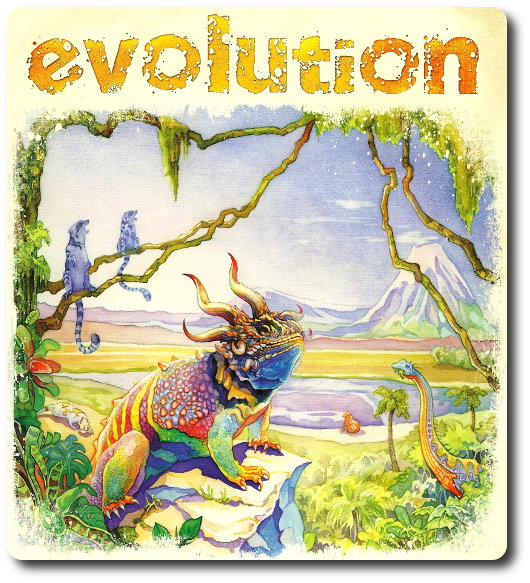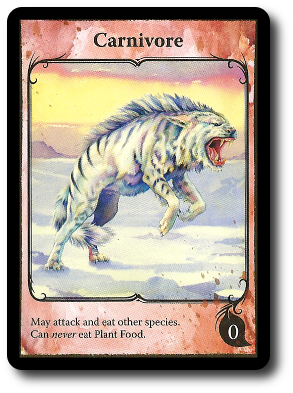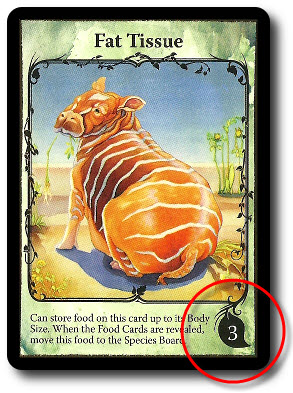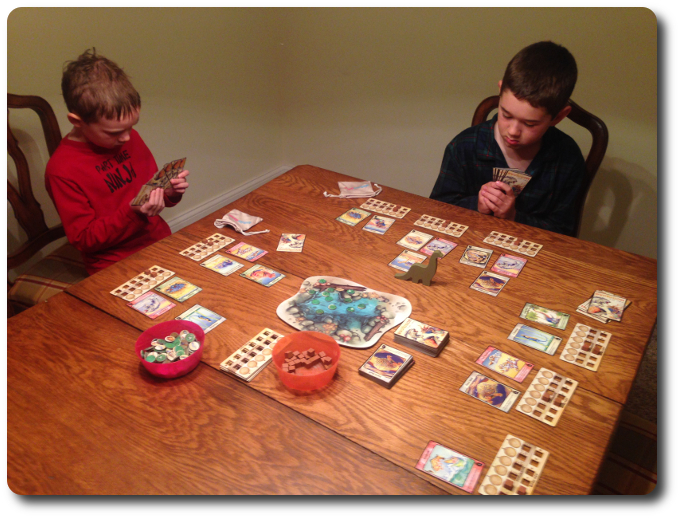
The Basics:
- For ages 8 and up (publisher suggests 12+)
- For 2 to 6 players
- Approximately 60 minutes to complete
Geek Skills:
- Counting & Math
- Logical & Critical Decision Making
- Reading
- Strategy & Tactics
- Risk vs. Reward
- Hand/Resource Management
Learning Curve:
- Child – Easy
- Adult – Easy
Theme & Narrative:
- Evolve or become extinct
Endorsements:
- Gamer Geek approved!
- Parent Geek approved!
- Child Geek approved!
Overview
Carl Sagan said, “Extinction is the rule. Survival is the exception.” Meaning all forms of life are destined to blink into existence and then just as quickly blink into oblivion. Rather dire thinking, really, but not necessarily incorrect. Survival is the fight against extinction, the daily battle to continue and thrive. In this game, you will help new species of animals grow and become strong by taking from the weak. But balance is all important, for without balance, even the strong will fall.
Evolution (Second Edition), designed by Dominic Crapuchettes, Dmitry Knorre, Sergey Machin, and published by North Star Games, is comprised of 1 Watering Hole board, 1 First Player marker (which is a big wooden dinosaur meeple – so cool), 129 Trait cards (17 Carnivore and 7 of each other Trait), 24 Species boards, 48 wooden markers, 180 Food tokens (double-sided, plants on one side, meat on the other), 6 Food token bags (with screen printed card illustrations), and 6 Player Aid cards (double-sided and very informative). The game’s component quality is excellent. As I am not familiar with this game’s first release, I cannot comment on the differences between the first and second edition. However, a complete (and rather detailed) list of the changes can be found on the North Star Games’ web page.
Down by the Watering Hole
To set up the game, first place the Watering Hole board in the middle of the playing area. All players should be able to reach it from their sitting (or standing) position.
Second, place all the Food tokens into a central pile. This is the Food pool (or bank) for the duration of the game. I suggest you put the tokens in a cup or bowl to keep your playing area organized. Give each player 1 Food token bag at this time, as well. Any Food token bags not used should go back in the game box.
Third, shuffle the Trait card and place the deck face-down to one side of the game playing area. This is the Trait draw deck for the duration of the game. Leave room for a discard pile.
Fourth, place the wooden markers to one side of the game playing area. They will be used, but are not called for during the game’s initial set up. Like the Food tokens, I suggest you put the wood tokens in a cup or a bowl. Place the Species boards to one side of the game playing area, as well. If necessary, give each player 1 Player Aid card.
That’s it for game set up. Determine who will go first and give them the First Player marker.
Playing the Game
Evolution is played in rounds and turns with no set number of rounds per game. Each round is broken down into phases where each player will take a turn starting with the First Player. A typical game round is summarized here.
Phase 1: Species Boards and Deal Trait Cards
First, give any player who does not currently have any species in front of them a Species board. When the game first starts, every player will need a Species board. When handing over the Species board, pass 2 wooden markers and place the markers on the “1” spaces found on the Population and Body Size tracks. All new Species boards begin as herbivores (plant eaters) until they evolve into carnivores (meat eaters) through a Trait card.

Second, deal each player 3 Trait cards, plus 1 additional Trait card for every species they have in front of them. If the Trait draw deck needs to be reshuffled during this phase of the round, this will be the last round of the game.
Phase 2: Select Food
The players now look at their Trait cards and select 1 to place face-down on the Watering Hole board. In the lower corner of the Trait cards is a number. This number indicates the amount of “Plant” Food tokens the card is worth. The order in which the Trait cards are placed face-down on the Watering Hole board is not important, but players should pay special attention to what cards they are playing and their value. When all the Trait cards are placed, they are collectively referred to as the “Food Cards”.

My favorite Food Card in the game…
Phase 3: Play Trait Cards
Staring with the First Player and continuing in turn order sequence, each player can play as many of their Trait cards as they like. Trait cards can do a number of things during this phase.
Play Traits to Species Board
If the player chooses, they may play Trait cards to their Species board. Trait cards are played above the Species board face-down (they will be flipped over at the end of this phase). There are only a few limitations when playing Trait cards to the Species board.
- A Species board may not have 2 or more Trait cards of the same type
- A Species board may not have more than 3 Trait cards
A player is welcome to discard 1 Trait card previously played to a Species board if they so choose in order to make room for a new Trait card. Discarded Trait cards are placed face-up in the Trait discard pile. Players should take a moment to consider which traits to give their species and how the Trait cards on the Species boards to the left and right impact game play. There are many different combinations that provide interesting effects, but not every Trait card goes well with others. In addition, not every Trait card should be played to a Species card.
Create New Species
Instead of adding Trait cards to an existing species, the player can discard 1 Trait card face-up to the Trait discard pile to obtain a new Species board. The newly acquire Species board is handed to the player along with 2 wooden markers that are placed on the “1” spaces of the Population and Body Size tracks.
When starting a new species, the Species board must be placed to the left or right of existing Species board, creating a row. Never in the middle. Think of it as adding to a chain. You don’t add a link by breaking the existing chain in half. Instead, you add a link to either end of the chain. The same goes for the Species boards. If table space is a concern, each Species board is double-sided with one side used for large playing areas (horizontal orientation) and the other side for smaller playing areas (vertical orientation). In all cases, Species boards are always placed in a row in front of he player.

Increase Population and Body Size
If the player thinks it is necessary, they can discard 1 Trait card face-up to the Trait discard pile to increase the Population or Body Size value (not both) on one of their Species boards by “+1”. The maximum value for both tracks is “6”.
After the player has completed their actions for this phase, the next player in turn order sequence now goes. After all the players have had a turn, the phase is over. All face-down Trait cards played to Species boards are now flipped over and revealed. Any Trait cards still in a player’s hand are saved for the next round of game play.
Phase 4: Feeding Frenzy
First, flip over the Food Cards located on the Watering Hole. The number values on the cards are added, resulting in this round’s total “Plant” food. An equal number of “Plant” Food tokens are then collected from the Food pool and placed on the Watering Hole board. If the resulting “Plant” food number from the Food Cards is a negative value, subtract an equal number of Plant” Food tokens from the Watering Hole board. For example, if the Watering Hole had 5 “Plant” Food tokens, but the Food Cards added up to “-4”, then “4” “Plant” Food tokens would be removed from the Watering Hole board.
When done calculating and adding (or subtracting) “Plant” Food tokens to the Watering Hole, the Food Cards are placed face-up in the Trait discard pile.
During this first portion of the phase, players should pay attention to their played Trait cards. Some have special effects that can be used. The order in which they activate is up to the player. Only Trait cards above Species boards can be used. Any in the player’s hand are not considered in play.
Second, each player must now feed their species, but only if the species is hungry. A species is considered “hungry” if the Population value is greater than the total amount of Food tokens on the Species board. Food tokens taken to feed a species are stored on the Species board above the Population and Body Size tracks, starting with the “1” space.
Beginning with the First Player, non-carnivore species are fed first. 1 “Plant” Food token is taken from the Watering Hole board and placed on the non-carnivorous Species board. Some Trait cards allow more than 1 Food token to be taken at this time, but a player may never collect more food than their Population track value. Animals don’t have refrigerators, you see.
After the plant eaters have been fed their salad, it’s time to feed the meat eaters. Carnivores are not able to survive eating the “Plant” Food tokens, even if they have a Trait card that would suggest otherwise. To satisfy their hunger, they must attack other species and even, if times are desperate, attack their own (meaning a player must devour their own species).
Attacking is pretty straight forward. Only a few rules apply.
- A carnivore can only attack another species if the attacking carnivore’s Body Size is greater than the Body Size of the species they want to attack.
- The carnivore must have a Trait card that overcomes the defensive Trait cards of the species they want to attack.
If the player can meet the 2 requirements, they have made a successful attack. The owner of the species who was just attacked (and thematically eaten) then does the following, while the attacking player feeds their species.
- Attacked species reduces their Population by “-1”. If the total Population is less than the total amount of Food tokens placed on the Species board, the extra Food tokens are given to the attacking player and placed in their Food token bag.
- The player who successfully attacked now collects a number of “Meat” Food tokens from the Food pool equal to the attacked species Body Size value. These are placed on the carnivore’s Species board, but the total amount of collected Food tokens cannot exceed the carnivore’s Population Size value.
Phase 5: Ending the Round
When all the players are done feeding their species, the round comes to an end. Any species that did not eat and collect Food tokens equal to its current Population value has their Population value reduced so it equals the total amount of Food tokens on the Species board.
All remaining Food tokens on the players’ Species boards are then removed and placed in the player’s individual Food token bag. All “Plant” Food tokens remaining on the Watering Hole stay for the next round.
This completest the round. The First Player marker is passed to the next player in turn order sequence and a new round beings.
Extinction and Ending the Game
If a Species board ever has its Population value reduced to “0”, the species becomes extinct. The Species board and all attached Trait cards are discarded. The player then draws a number of new Trait cards equal to the Trait cards lost due to the species going extinct. If a gap was created between the player’s Species board row, the gap is closed by moving the remaining Species boards closer together.
The game can end one of two different ways. Both are triggered when the Trait draw deck is exhausted and the discard pile needs to be shuffled to create a new Trait draw deck.
- If the Trait discard pile is shuffled to create a new draw deck during phase 1 of the round, the game ends when the round is completed.
- If the Trait discard pile is shuffled to create a new draw deck at any other time during the game, the game ends when the next round (not the current round) is completed.
When the game ends, players count their points.
- Each player earns 1 point for every Food token in their Food token bag.
- Each player earns points equal to all their Species board Population values.
- Each player earns 1 point for every Trait card attached to a Species board.
The player with the most points wins the game. Ties are broken by determining which player has the most Trait cards.
Game Variants
Evolution for Two
The base game requires 3 to 5 players, but if only 2 are available, the game can still be enjoyed. The same game rules apply, but 40 Trait cards are removed at random during game set up. Additionally, each Species board can only have 2 Trait cards attached instead of 3.
A Game for Six Players and Quickening the Process of Evolution
Evolution can be played with up to 6 players, but the game play changes slightly to keep game play brisk. As it turns out, the same rules that are used for 6-player games can be used with any other number of players to hasten game play. During phase 3, players play any Trait cards they like at the same time instead of in turn order sequence. Players can still wait until an opponent plays a card before selecting one from their hand, but it’s no longer necessary to wait at all.
To learn more about Evolution (Second Edition), visit the game’s web page.
Final Word
The Child Geeks were really taken with this game. They saw each species as if they were creating a special animal. One Child Geek said, “This game reminds me of Pokémon! You have to evolve your creature and then attack. But instead of energy, you are eating salad or legs.” Which I found to be just hilarious, but not incorrect. Another Child Geek said, “This game is so easy to learn, but the second I started playing it, I was like, whoa! Hold up! It’s hard to survive!” In this Child Geek’s case, they had some difficulty at first balancing the Food tokens as a resource. All of the Child Geeks did, in fact, until they started to understand how Population, Body Size, and Food all work together. When they made that connection, they did great and the games were fun to watch. Some very creative species were created and some that were destined to die out. When the last game was played, all the Child Geeks voted to approve Evolution.

Time to evolve… (followed by a quick apple juice break)
The Parent Geeks were also very pleased. A number of them had already played the first edition of the game and found the second edition to be of equal or greater value than the original. For those who were new to the game, they found Evolution to be an easy, but strangely challenging game of resource management and killer combos. According to one Parent Geek, “There is more to this game than simply pushing your luck to create a large species. You have to manage your growth, play the right cards that will protect, and then keep the carnivores the hell out-of-the-way.” Speaking of carnivores, one Parent Geek said, “This game is very, very clever. I like how every species is plant eater by default, but players can make their species a carnivore later or right away. Even better, carnivores are sometimes forces to eat species in their own rows to simply survived. I really, really like that.” So much did the Parent Geeks like Evolution, in fact, that enthusiastically voted to approve it.
I was unable to find a single Gamer Geek who had not heard of or had already played Evolution. From their perspective, the second edition of the game was just as good if not a little bit better than the first. According to one Gamer Geek, “What has always made this game entertaining to me is the many different ways you can come at the game. The combos are endless and setting up Trait cards to assist your species to the left and right of you is a lot of fun. The game is still great.” Another Gamer Geek remarked, “This game is solid. No single Trait is better than another. You have to mix, match, and build your species. Even then, your best efforts might not be enough if there is not enough food. Balance is key in this game and that allows for near limitless strategy and tactics to achieve your goals.” None of the Gamer Geeks found fault in the game, but all agreed that Evolution was still a light game, perfect for evenings when gaming elitists wanted a game with teeth, but not with a strong bite. All the Gamer Geeks approved Evolution.
Having not played the first edition of the game, I am unable to say if this edition is an improvement. Luckily, there were more than a few players available who had. The second edition was, in their collective opinion, tighter, more organized, and better presented. The core game play was found to be the same in both editions, suggesting that the second edition was not a mandatory upgrade for those who already had the first edition. According to one Parent Geek who has played Evolution a great deal, “The second edition is like a re-release with a bit more chrome. It’s a must for those who want the game, but not for those who already have the first version.”
Personally, I really enjoyed myself. This is a game with surprising depth, but it doesn’t dunk players into the deep end of the pool. Strategy and tactics evolve (pardon the pun) naturally as opponents begin to define their species. Players act and react, much in the same way that nature does, I suppose. Where there is an opening for advancement, the player takes it, When an obvious threat emerges, the player takes the proper defensive steps. But knee jerk reactions are not what this game is about. Players must think both short and long-term. One must survive the round, as well as the many to come. That makes for some very interesting questions to ponder, strategies to develop, and tactics to deploy.
As a family gamer and a recovering gaming elitist, I recommend Evolution. Its game play is unique, yet the game is so approachable that players will immediately feel at home. This is a game of depth that opens and gets bigger at the speed set by the players. The biggest challenge is not the opponent, but your own ability to balance and perceive strengths and weaknesses and then exploit them through Trait card or through other means. Simply excellent, fun, and engaging. If this sounds like a game you’d enjoy, do sit down and play it with family and friends.
This is a paid for review of the game’s final prototype. Although our time and focus was financially compensated, our words are our own. We’d need at least 10 million dollars before we started saying what other people wanted. Such is the statuesque and legendary integrity of Father Geek which cannot be bought except by those who own their own private islands and small countries.




Pingback: Evolution: Flight Game Expansion Review - Father Geek
Pingback: Evolution: Climate Game Review (prepublished version) – Father Geek
Realize this review was probably written a while ago with pre-release rules but a couple of things I noticed that would be nice to have clarified:
“After the plant eaters have been fed their salad, it’s time to feed the meat eaters.”
Implies the carnivores don’t eat until later in the turn order, which isn’t true (and presumably not what you meant).
“Attacked species reduces their Population by “-1”. If the total Population is less than the total amount of Food tokens placed on the Species board, the extra Food tokens are given to the attacking player and placed in their Food token bag.”
This might have changed in the final release but the attacked player keeps all of their food even if the species finishes with less population or goes extinct. Game would be much more take that with your version.